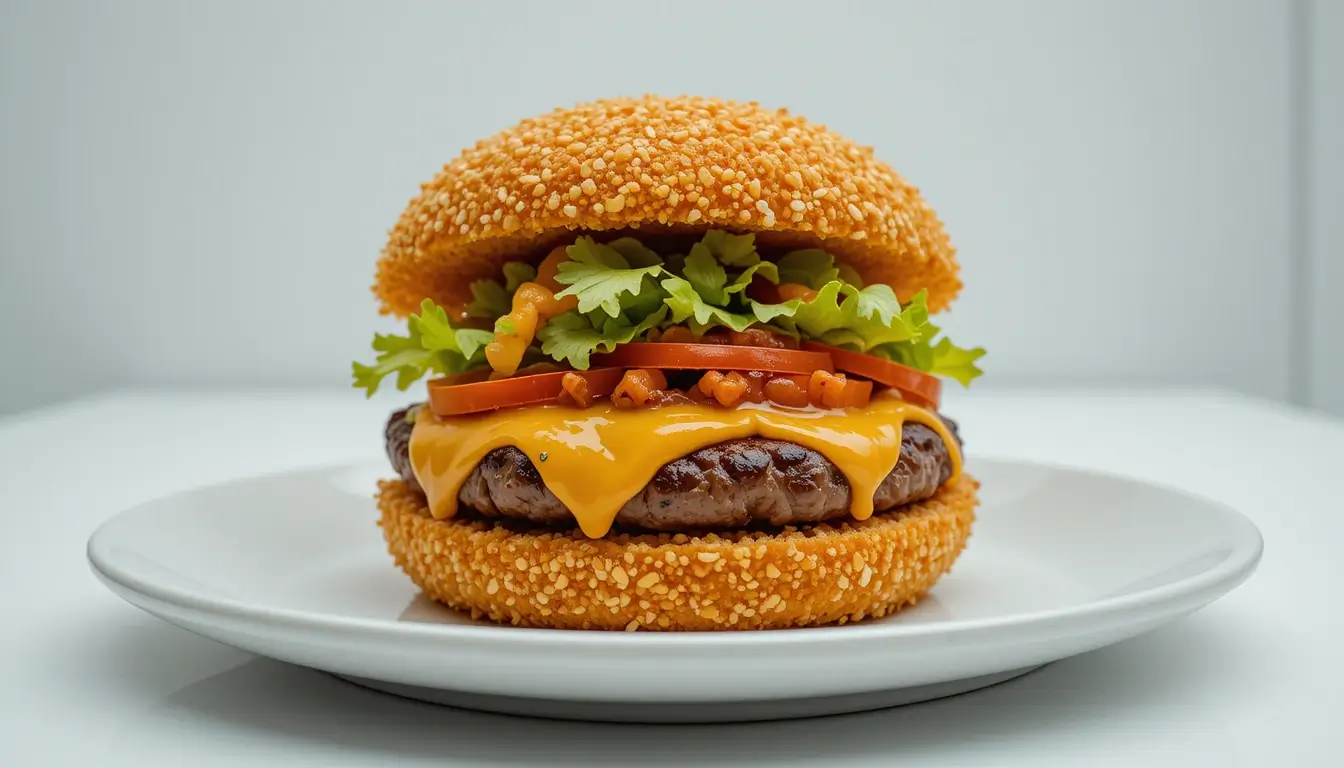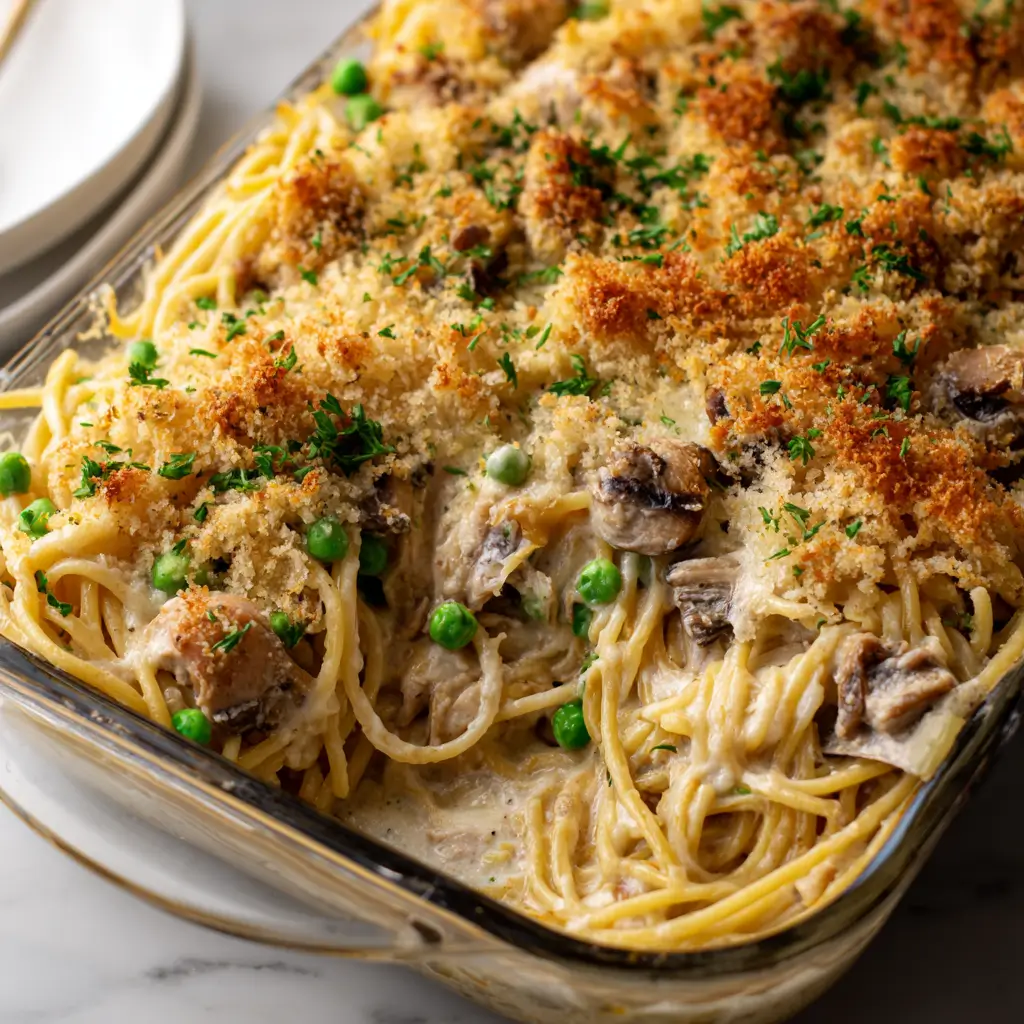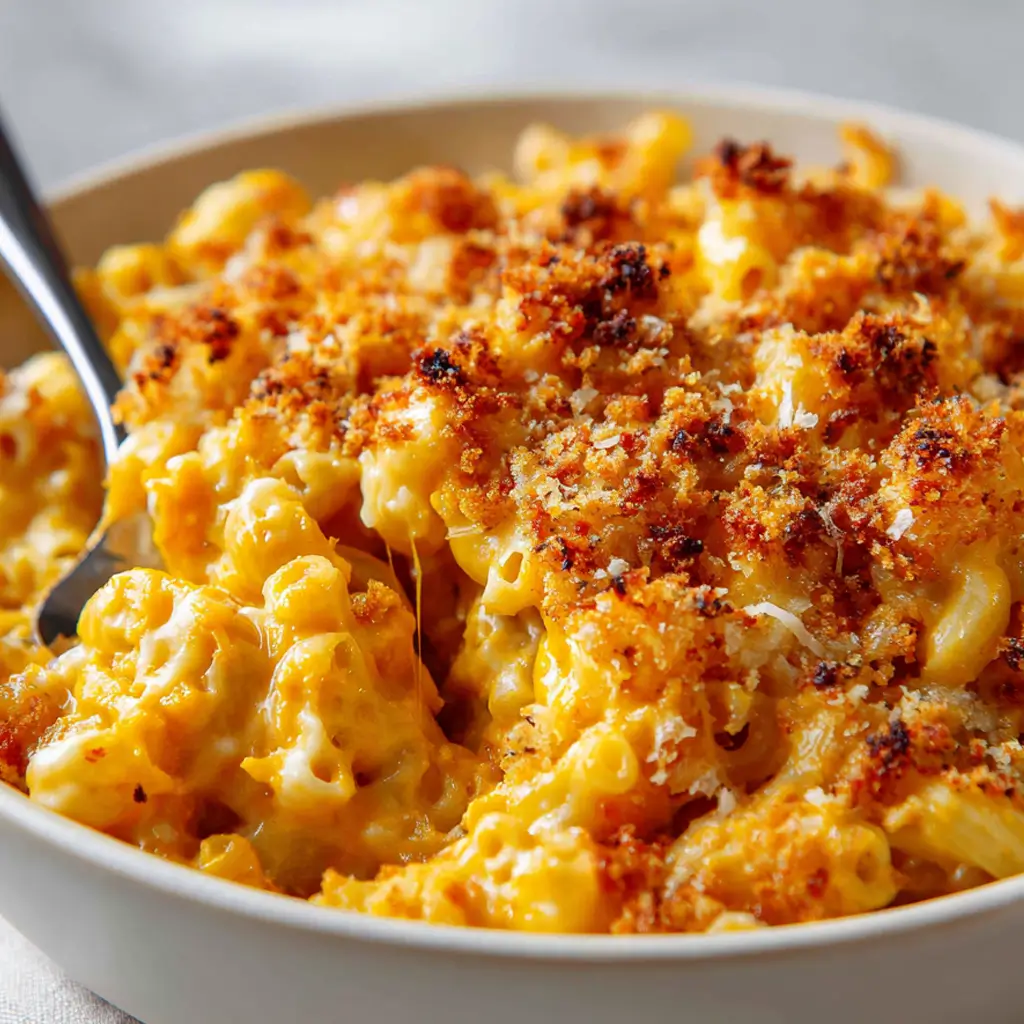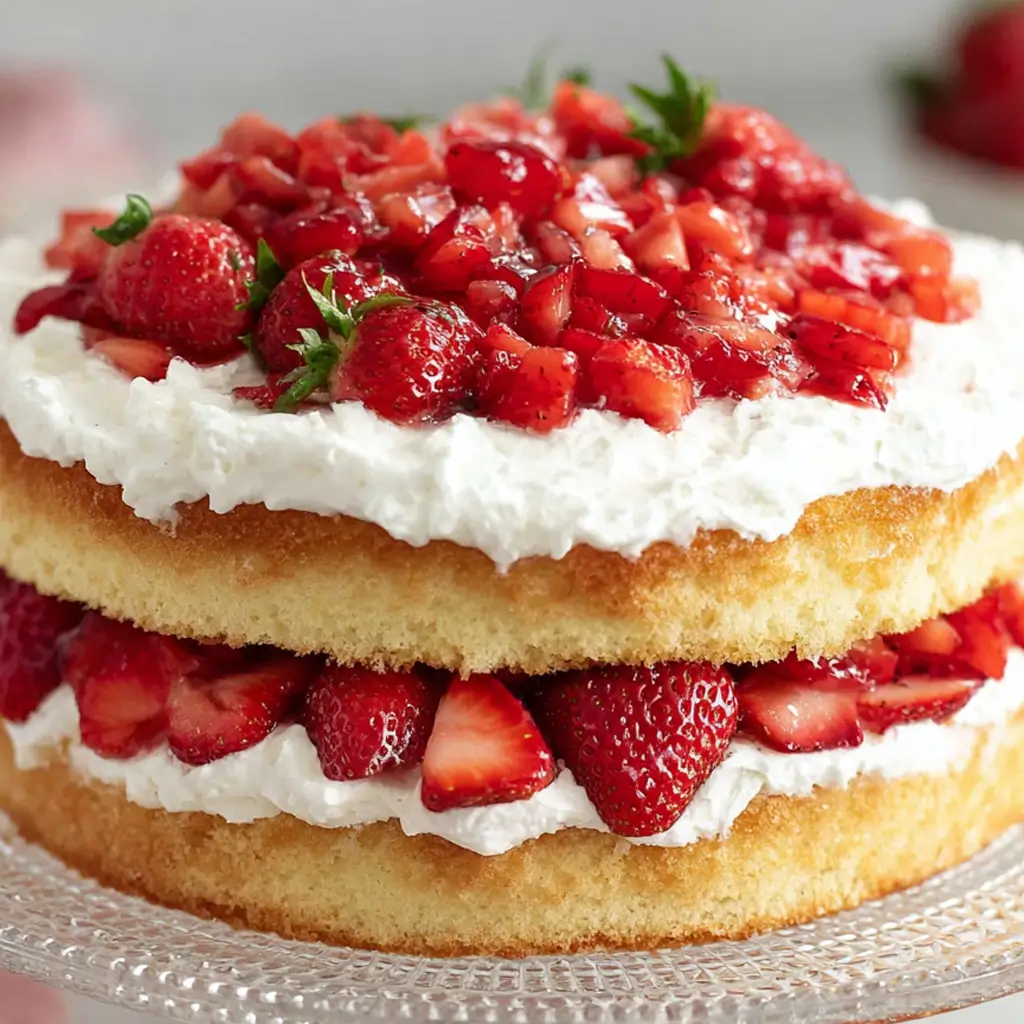Introduction: A Crispy, Juicy Delight!
If you’re a burger lover looking to level up your game, this deep fried hamburger recipe is the ultimate treat. Imagine biting into a golden, crispy crust that gives way to a juicy, perfectly seasoned beef patty. This indulgent twist on the classic hamburger is perfect for food enthusiasts who love bold flavors and textures. Whether you’re serving it at a backyard barbecue, a game-day party, or a casual dinner, this dish is bound to be a showstopper.
In this article, we’ll guide you through every step of creating the perfect deep-fried hamburger, from choosing the best ingredients to mastering the frying technique. Plus, we’ll include creative variations, serving suggestions, and tips to ensure your burgers turn out flawless every time. Let’s dive in!
Why You’ll Love This Deep-Fried Hamburger Recipe
Here’s why this recipe deserves a place in your kitchen:
- Extra Crispy Goodness: The golden crust created by frying elevates the texture of your burger. It’s like a crunch party in your mouth!
- Juicy Interior: Frying locks in moisture, ensuring every bite is packed with juicy, flavorful meat.
- Customizable: This recipe can be adapted to suit different tastes and dietary needs. From gluten-free coatings to alternative protein options, the possibilities are endless.
- Easy to Make: With the right tips and instructions, deep-frying burgers is surprisingly simple and quick.
Key Ingredients for the Best Deep-Fried Hamburger
To create a deep-fried hamburger that is both crispy and flavorful, the ingredients you choose are crucial. Here’s a breakdown of what you’ll need and why:
Patties:
- Ground Beef (80/20): This ratio ensures the perfect balance of fat and meat for a juicy burger.
Substitution: Use ground chicken or turkey for a leaner option. If you’re a fan of unique flavor twists, consider trying the spices used in this Vegetarian Chili Recipe. - Seasonings: A mix of salt, black pepper, garlic powder, and onion powder enhances the natural flavors of the beef.
Coating:
- Flour: Acts as the base layer, helping the batter stick to the burger.
- Egg Wash: A mixture of eggs and milk creates a glue-like layer to hold the breadcrumbs in place.
- Breadcrumbs or Panko: Provides the ultimate crispy exterior. For an extra crunch, check out techniques inspired by this Cheeseburger Tater Tot Casserole.
For Frying:
- Neutral Oil (e.g., Canola or Vegetable Oil): Ideal for frying due to its high smoke point and neutral flavor.
- Optional Seasonings for Coating: Paprika, cayenne pepper, or dried herbs can be added for extra flavor in the crust.
Ingredients List (At-a-Glance)
Patties:
- 1 lb ground beef (80/20)
- 1 tsp salt
- 1 tsp black pepper
- 1 tsp garlic powder
- 1 tsp onion powder
Coating:
- 1 cup all-purpose flour
- 2 large eggs
- ¼ cup milk
- 1 ½ cups breadcrumbs or panko
Frying:
- 4 cups canola or vegetable oil
Optional Toppings & Buns:
- Burger buns
- Lettuce, tomato, onions
- Cheese slices (cheddar, Swiss, or your favorite)
- Condiments (ketchup, mustard, mayo, etc.)
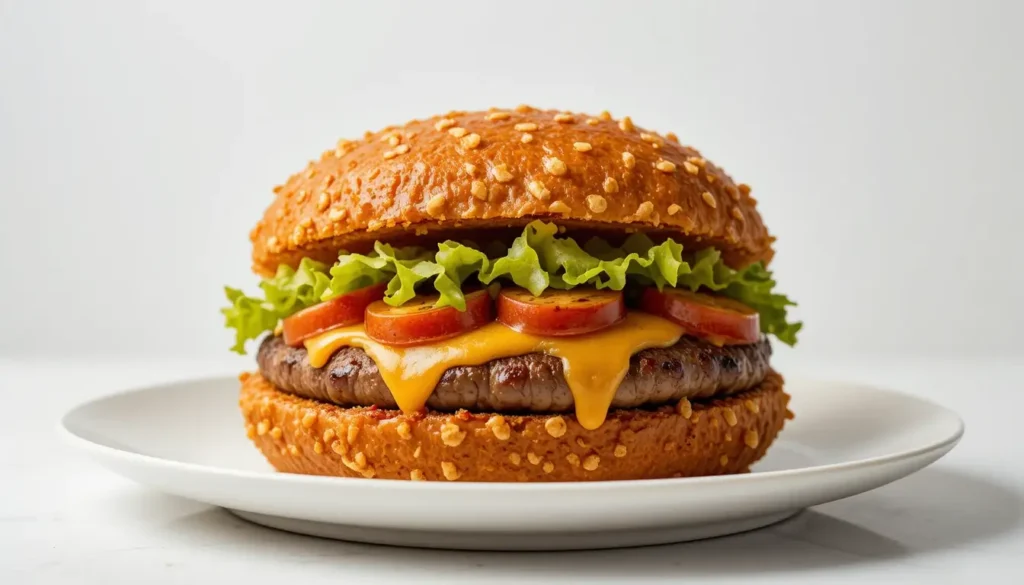
Step-by-Step Instructions: How to Make a Deep-Fried Hamburger
Prepare the Patties
- Choose Quality Meat: Start with fresh ground beef (80/20 blend is best). The fat content ensures your burgers remain juicy and flavorful even after frying.
- Season Evenly: Place the ground beef in a mixing bowl and sprinkle in your seasonings (salt, black pepper, garlic powder, and onion powder). Avoid overmixing, as this can make the patties dense. Instead, use your hands to gently fold the seasoning into the meat until just combined.
- Shape Your Patties: Divide the mixture into 4 equal portions. Flatten each portion into a patty about ½ inch thick and slightly larger than the diameter of your burger buns (to account for shrinkage during cooking).
- Pro Tip: Use your thumb to press a small indentation in the center of each patty. This prevents the burger from puffing up in the middle while frying.
- Chill the Patties: Place the shaped patties on a plate, cover with plastic wrap, and refrigerate for at least 30 minutes. This step helps the patties firm up, making them easier to coat and fry.
Set Up Your Coating Station
- Prepare a Triple Dipping Station:
- Bowl 1: Add 1 cup of flour. For extra flavor, mix in ½ teaspoon of paprika, a pinch of cayenne pepper, or dried herbs.
- Bowl 2: Whisk together 2 eggs and ¼ cup of milk in another bowl. This forms the “glue” to hold the breadcrumbs in place.
- Bowl 3: Pour 1 ½ cups of breadcrumbs or panko into the final bowl. For more texture, lightly crush panko with your hands before using.
- Organize for Efficiency: Line up the bowls in order, and set a baking sheet at the end for the coated patties. This will minimize mess and make the process smoother.
Coat the Patties
- Flour First: Take a chilled patty and lightly dredge it in the flour. Ensure all sides are coated evenly, but shake off any excess flour to avoid clumps.
- Why Flour First? This step helps the egg wash adhere better to the patty.
- Egg Wash: Dip the floured patty into the egg mixture. Use a fork or tongs to flip it, ensuring it’s fully coated on both sides. Allow any excess egg wash to drip off.
- Breadcrumb Magic: Transfer the patty to the breadcrumb bowl and press the crumbs onto the surface, ensuring a thick, even coating. For added crunch, gently press more breadcrumbs onto the patty after the initial coat.
- Double-Coating Option: If you want an extra-thick crust, repeat the flour, egg, and breadcrumb steps once more.
- Repeat for All Patties: Once all the patties are coated, place them on the prepared baking sheet. Let them sit for 5 minutes to help the coating set.
Heat the Oil
- Choose the Right Pot: Use a heavy-bottomed pot or a deep fryer to ensure even heat distribution. A cast iron pot works wonderfully.
- Fill with Oil: Pour in enough canola or vegetable oil to submerge the patties completely (at least 3–4 inches deep).
- Heat to 350°F (175°C): Use a kitchen thermometer to monitor the temperature. If the oil is too hot, the coating will burn before the patty cooks through. If it’s too cool, the crust will absorb excess oil and turn greasy.
- Safety Tip: Never leave hot oil unattended, and have a lid nearby in case of splatters.
Fry the Patties
- Fry One at a Time: Gently lower one patty into the hot oil using a slotted spoon or tongs. Frying too many at once can lower the oil temperature, resulting in uneven cooking.
- Monitor Cooking Time: Cook each patty for about 3–4 minutes per side. Flip gently to avoid breaking the coating. The crust should turn a deep golden brown.
- Check Doneness: Use a meat thermometer to ensure the internal temperature reaches 160°F (71°C) for food safety.
- Drain Excess Oil: Once cooked, remove the patty and place it on a wire rack set over a baking sheet. This allows excess oil to drip off while keeping the crust crispy. Avoid placing the patties directly on paper towels, as this can make them soggy.
Assemble Your Burgers
- Toast the Buns: Lightly butter the cut sides of your burger buns and toast them on a skillet or grill until golden. This adds flavor and prevents the buns from getting soggy.
- Layer It Up: Start with a piece of lettuce on the bottom bun (to act as a barrier against juices), followed by the fried patty. Add a slice of cheese, tomato, onion, and your favorite condiments.
- Serve Hot: Serve the assembled burgers immediately for the best taste and texture.
Variations to Try
- Cheese-Stuffed Patties: Place a cube of cheese in the center of each patty before shaping and frying.
- Spicy Coating:Add cayenne pepper or chili powder to the breadcrumb mixture for a kick. If you love spice, the flavors in this Chipotle Ranch Grilled Chicken Burrito might inspire you.
- Vegetarian Option: Substitute the beef patty with a veggie burger or a portobello mushroom cap.
- Gluten-Free Version: Use almond flour and gluten-free breadcrumbs.
Serving Suggestions
Serve your deep-fried hamburger with these delicious accompaniments:
- Crispy Fries: Go classic with shoestring fries or sweet potato fries. For something hearty and comforting, consider Slow Cooker Chicken and Mushroom Stroganoff.
- Coleslaw: A tangy, crunchy slaw complements the rich burger.
- Pickles: Add a burst of acidity with dill pickles or pickled onions.
- Milkshake: A creamy vanilla or chocolate milkshake pairs wonderfully with the crispy burger.
Tips for the Best Deep-Fried Hamburger
1. Handle the Meat Gently
- Overworking the ground beef can result in tough, dense patties. Mix just until the seasonings are incorporated, and avoid pressing the patties too hard when shaping.
2. Keep Everything Cold
- Cold patties hold their shape better and are less likely to fall apart during frying. If your kitchen is warm, chill the patties again after coating them.
3. Use a Thermometer
- An oil thermometer ensures you’re frying at the correct temperature. Maintaining a steady 350°F (175°C) prevents the coating from burning or absorbing too much oil.
- A meat thermometer guarantees the patty is cooked through without overcooking the crust.
4. Don’t Crowd the Pot
- Frying too many patties at once lowers the oil temperature and leads to uneven cooking. Cook in small batches for the best results.
5. Experiment with Coating Flavors
- Mix grated Parmesan cheese, crushed cornflakes, or finely ground nuts into the breadcrumbs for a unique twist.
6. Test with a Small Piece
- Before frying the first patty, test the oil temperature by frying a small piece of the coating. This ensures the oil is ready and helps you adjust seasoning if needed.
7. Drain Properly
- Always place fried patties on a wire rack instead of paper towels. This keeps them crispy by allowing air to circulate around the crust.
8. Assemble Just Before Serving
- To maintain maximum crispiness, assemble the burgers right before serving. The longer the patties sit with toppings, the softer the crust becomes.
9. Use Fresh Oil
- If frying multiple batches, ensure the oil remains clean. Strain out any crumbs between batches to prevent burning, which can affect flavor.
10. Store and Reheat Properly
-
- If you have leftovers, store patties in an airtight container in the fridge. Reheat in an oven or air fryer to restore crispiness. Avoid microwaving, as this can make the crust soggy.
Benefits of This Deep-Fried Hamburger
- Easy to Make: Despite sounding fancy, the steps are straightforward and beginner-friendly.
- Versatile: You can adapt the recipe to suit dietary needs or flavor preferences.
- Memorable: This recipe creates a burger that stands out from the crowd.
Can You Deep Fry a Hamburger?
Yes, you can deep fry a hamburger! While frying burgers isn’t the most common cooking method, it produces a crispy outer crust and locks in the juicy interior. Deep-fried hamburgers are popular in some restaurants and can be made at home with the right approach.
Is Deep-Fried Beef a Thing?
Absolutely, deep-fried beef is a real cooking technique! It’s often used in Asian cuisines, such as in crispy beef dishes or stir-fries, and also in modern Western kitchens. Deep frying gives beef a rich, crunchy texture while maintaining its tenderness inside.
Examples of deep-fried beef dishes include:
- Crispy beef strips for stir-fry or appetizers.
- Deep-fried steaks for an extra indulgent crust.
- Breaded and fried beef patties, like burgers or fritters.
How Long Should a Burger Be Fried?
The frying time for a burger depends on its thickness and desired doneness:
- Thin patties: 2-3 minutes per side for medium doneness.
- Thick patties: 3-4 minutes per side for medium doneness.
When deep frying burgers:
- Heat oil to 350°F (175°C).
- Fry for 3-4 minutes total for a medium-well result.
- Use a thermometer to ensure the internal temperature reaches 160°F (71°C) for safe consumption.
What Is the Best Oil to Fry Burgers In?
The best oil for frying burgers should have a high smoke point and a neutral flavor. Good options include:
- Canola Oil
- Smoke point: 400°F (204°C)
- Affordable and widely available.
- Peanut Oil
- Smoke point: 450°F (232°C)
- Great for deep frying with a subtle nutty taste.
- Vegetable Oil
- Smoke point: ~400°F (204°C)
- Versatile and budget-friendly.
- Avocado Oil (premium option)
- Smoke point: 520°F (271°C)
- Healthy and adds a mild, buttery flavor.
Conclusion
This deep-fried hamburger recipe is the perfect way to indulge your taste buds with a crispy, juicy, and flavor-packed burger. Whether you’re hosting a party or simply treating yourself, this dish is guaranteed to impress. So, gather your ingredients, heat up the oil, and dive into the world of crispy burger bliss!
If you try this recipe, don’t forget to share your creations in the comments or on social media. We’d love to see your delicious results. Happy cooking!
